Tort Law: Detailed Analysis of Negligence, Nuisance, and Case Studies
VerifiedAdded on 2022/12/06
|13
|3576
|249
Report
AI Summary
This report provides an in-depth analysis of tort law, focusing on the concepts of negligence and nuisance. It begins with an introduction to tort law as a civil wrong leading to legal liability and the pursuit of compensation. The main body of the report examines two case scenarios. The first case explores negligence, specifically the breach of duty of care by a company (VES) that ignored warnings about a faulty product, leading to damages. The second case delves into nuisance, distinguishing between public and private nuisance, and analyzes the landmark case of Rylands v. Fletcher to illustrate the principles of strict liability for non-natural uses of land. The report concludes by summarizing the key findings and referencing relevant legal sources.
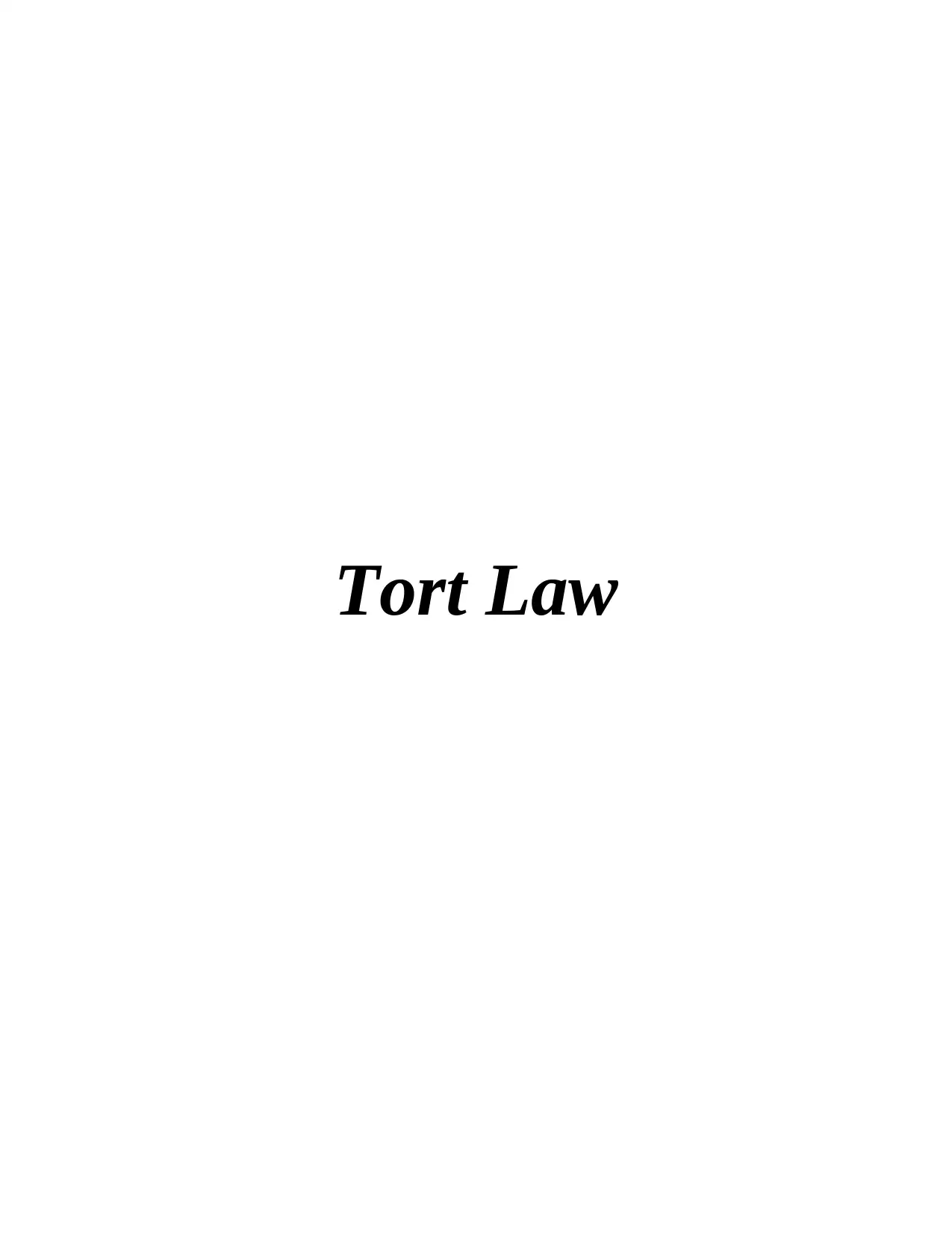
Tort Law
Paraphrase This Document
Need a fresh take? Get an instant paraphrase of this document with our AI Paraphraser
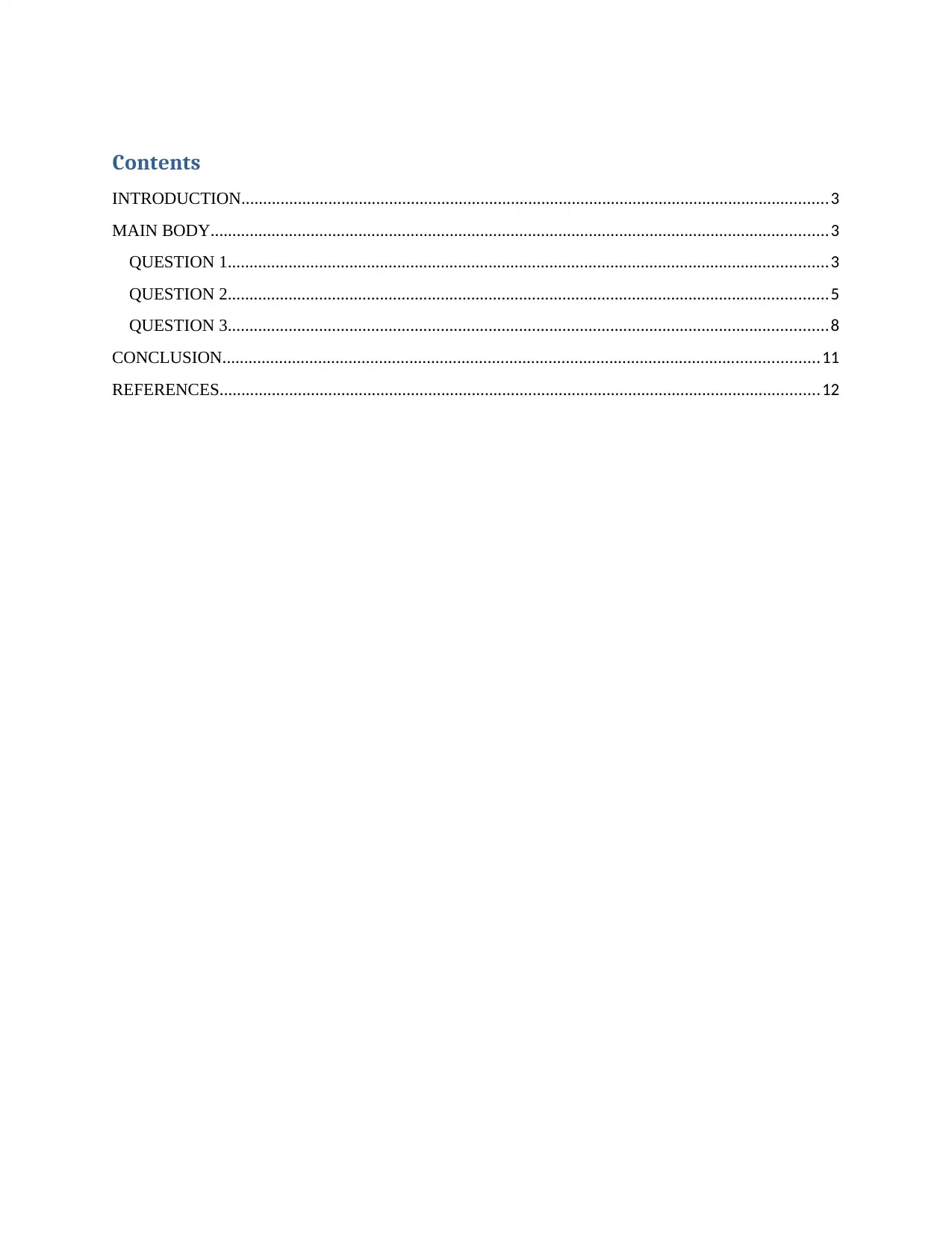
Contents
INTRODUCTION.......................................................................................................................................3
MAIN BODY..............................................................................................................................................3
QUESTION 1..........................................................................................................................................3
QUESTION 2..........................................................................................................................................5
QUESTION 3..........................................................................................................................................8
CONCLUSION.........................................................................................................................................11
REFERENCES..........................................................................................................................................12
INTRODUCTION.......................................................................................................................................3
MAIN BODY..............................................................................................................................................3
QUESTION 1..........................................................................................................................................3
QUESTION 2..........................................................................................................................................5
QUESTION 3..........................................................................................................................................8
CONCLUSION.........................................................................................................................................11
REFERENCES..........................................................................................................................................12
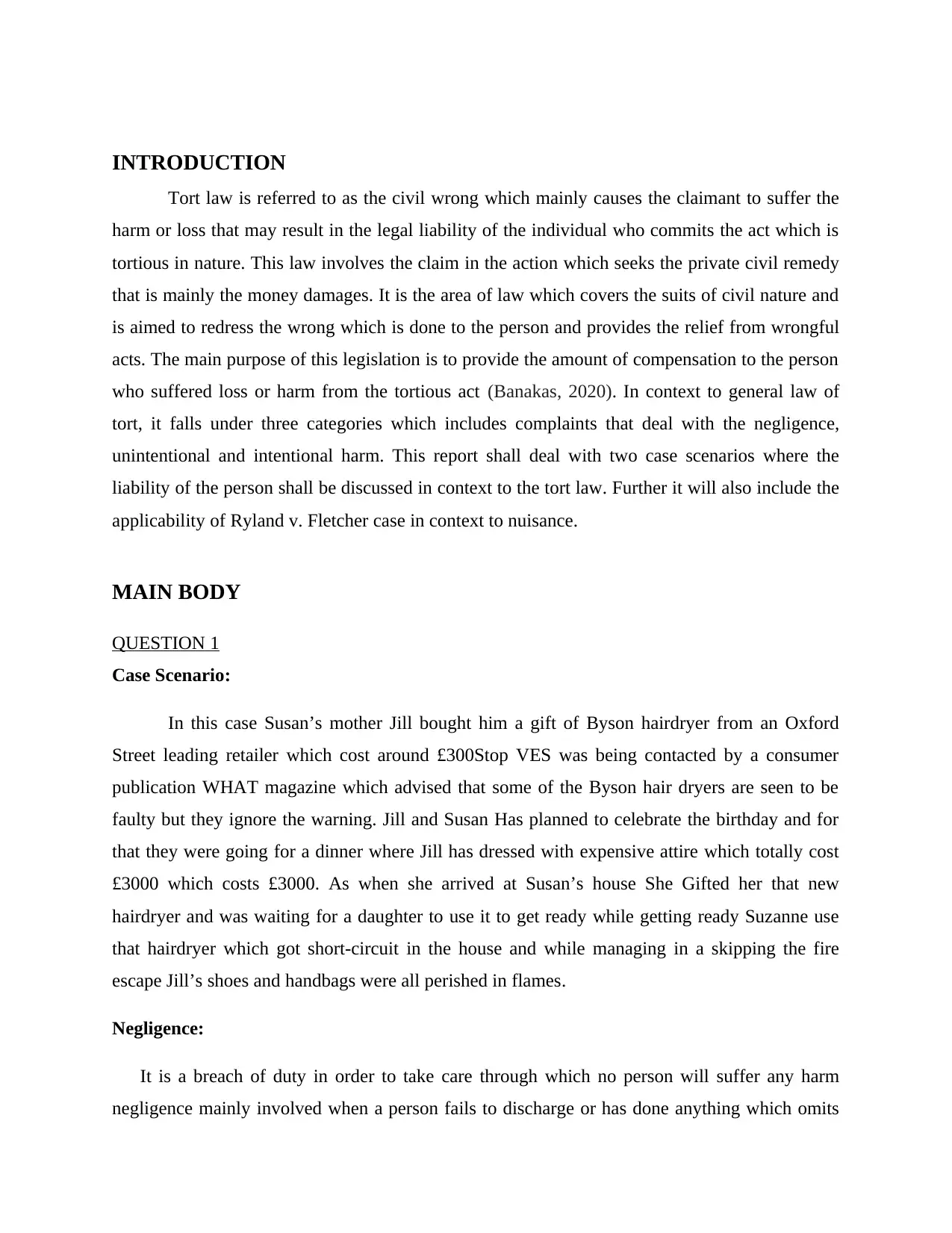
INTRODUCTION
Tort law is referred to as the civil wrong which mainly causes the claimant to suffer the
harm or loss that may result in the legal liability of the individual who commits the act which is
tortious in nature. This law involves the claim in the action which seeks the private civil remedy
that is mainly the money damages. It is the area of law which covers the suits of civil nature and
is aimed to redress the wrong which is done to the person and provides the relief from wrongful
acts. The main purpose of this legislation is to provide the amount of compensation to the person
who suffered loss or harm from the tortious act (Banakas, 2020). In context to general law of
tort, it falls under three categories which includes complaints that deal with the negligence,
unintentional and intentional harm. This report shall deal with two case scenarios where the
liability of the person shall be discussed in context to the tort law. Further it will also include the
applicability of Ryland v. Fletcher case in context to nuisance.
MAIN BODY
QUESTION 1
Case Scenario:
In this case Susan’s mother Jill bought him a gift of Byson hairdryer from an Oxford
Street leading retailer which cost around £300Stop VES was being contacted by a consumer
publication WHAT magazine which advised that some of the Byson hair dryers are seen to be
faulty but they ignore the warning. Jill and Susan Has planned to celebrate the birthday and for
that they were going for a dinner where Jill has dressed with expensive attire which totally cost
£3000 which costs £3000. As when she arrived at Susan’s house She Gifted her that new
hairdryer and was waiting for a daughter to use it to get ready while getting ready Suzanne use
that hairdryer which got short-circuit in the house and while managing in a skipping the fire
escape Jill’s shoes and handbags were all perished in flames.
Negligence:
It is a breach of duty in order to take care through which no person will suffer any harm
negligence mainly involved when a person fails to discharge or has done anything which omits
Tort law is referred to as the civil wrong which mainly causes the claimant to suffer the
harm or loss that may result in the legal liability of the individual who commits the act which is
tortious in nature. This law involves the claim in the action which seeks the private civil remedy
that is mainly the money damages. It is the area of law which covers the suits of civil nature and
is aimed to redress the wrong which is done to the person and provides the relief from wrongful
acts. The main purpose of this legislation is to provide the amount of compensation to the person
who suffered loss or harm from the tortious act (Banakas, 2020). In context to general law of
tort, it falls under three categories which includes complaints that deal with the negligence,
unintentional and intentional harm. This report shall deal with two case scenarios where the
liability of the person shall be discussed in context to the tort law. Further it will also include the
applicability of Ryland v. Fletcher case in context to nuisance.
MAIN BODY
QUESTION 1
Case Scenario:
In this case Susan’s mother Jill bought him a gift of Byson hairdryer from an Oxford
Street leading retailer which cost around £300Stop VES was being contacted by a consumer
publication WHAT magazine which advised that some of the Byson hair dryers are seen to be
faulty but they ignore the warning. Jill and Susan Has planned to celebrate the birthday and for
that they were going for a dinner where Jill has dressed with expensive attire which totally cost
£3000 which costs £3000. As when she arrived at Susan’s house She Gifted her that new
hairdryer and was waiting for a daughter to use it to get ready while getting ready Suzanne use
that hairdryer which got short-circuit in the house and while managing in a skipping the fire
escape Jill’s shoes and handbags were all perished in flames.
Negligence:
It is a breach of duty in order to take care through which no person will suffer any harm
negligence mainly involved when a person fails to discharge or has done anything which omits
⊘ This is a preview!⊘
Do you want full access?
Subscribe today to unlock all pages.

Trusted by 1+ million students worldwide
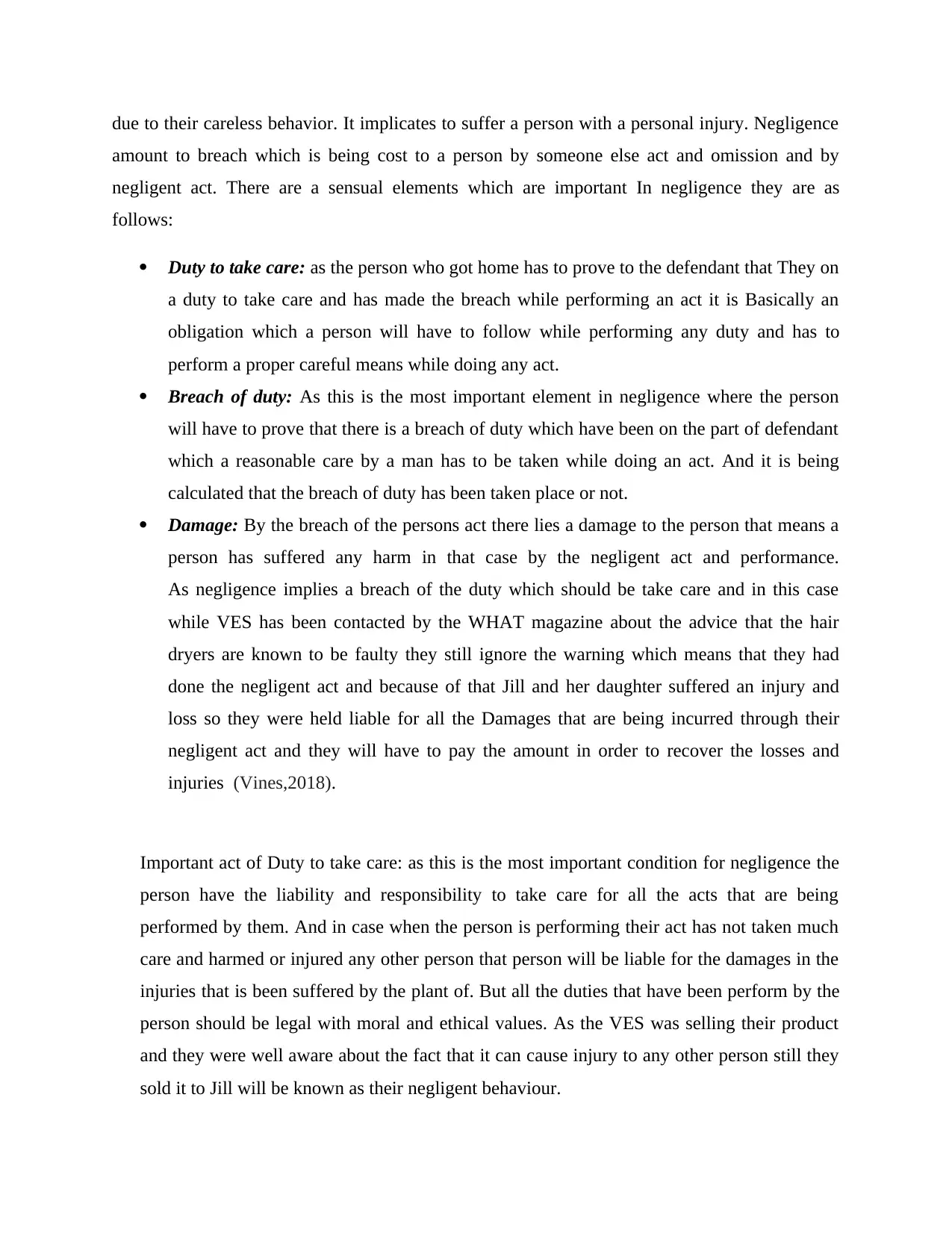
due to their careless behavior. It implicates to suffer a person with a personal injury. Negligence
amount to breach which is being cost to a person by someone else act and omission and by
negligent act. There are a sensual elements which are important In negligence they are as
follows:
Duty to take care: as the person who got home has to prove to the defendant that They on
a duty to take care and has made the breach while performing an act it is Basically an
obligation which a person will have to follow while performing any duty and has to
perform a proper careful means while doing any act.
Breach of duty: As this is the most important element in negligence where the person
will have to prove that there is a breach of duty which have been on the part of defendant
which a reasonable care by a man has to be taken while doing an act. And it is being
calculated that the breach of duty has been taken place or not.
Damage: By the breach of the persons act there lies a damage to the person that means a
person has suffered any harm in that case by the negligent act and performance.
As negligence implies a breach of the duty which should be take care and in this case
while VES has been contacted by the WHAT magazine about the advice that the hair
dryers are known to be faulty they still ignore the warning which means that they had
done the negligent act and because of that Jill and her daughter suffered an injury and
loss so they were held liable for all the Damages that are being incurred through their
negligent act and they will have to pay the amount in order to recover the losses and
injuries (Vines,2018).
Important act of Duty to take care: as this is the most important condition for negligence the
person have the liability and responsibility to take care for all the acts that are being
performed by them. And in case when the person is performing their act has not taken much
care and harmed or injured any other person that person will be liable for the damages in the
injuries that is been suffered by the plant of. But all the duties that have been perform by the
person should be legal with moral and ethical values. As the VES was selling their product
and they were well aware about the fact that it can cause injury to any other person still they
sold it to Jill will be known as their negligent behaviour.
amount to breach which is being cost to a person by someone else act and omission and by
negligent act. There are a sensual elements which are important In negligence they are as
follows:
Duty to take care: as the person who got home has to prove to the defendant that They on
a duty to take care and has made the breach while performing an act it is Basically an
obligation which a person will have to follow while performing any duty and has to
perform a proper careful means while doing any act.
Breach of duty: As this is the most important element in negligence where the person
will have to prove that there is a breach of duty which have been on the part of defendant
which a reasonable care by a man has to be taken while doing an act. And it is being
calculated that the breach of duty has been taken place or not.
Damage: By the breach of the persons act there lies a damage to the person that means a
person has suffered any harm in that case by the negligent act and performance.
As negligence implies a breach of the duty which should be take care and in this case
while VES has been contacted by the WHAT magazine about the advice that the hair
dryers are known to be faulty they still ignore the warning which means that they had
done the negligent act and because of that Jill and her daughter suffered an injury and
loss so they were held liable for all the Damages that are being incurred through their
negligent act and they will have to pay the amount in order to recover the losses and
injuries (Vines,2018).
Important act of Duty to take care: as this is the most important condition for negligence the
person have the liability and responsibility to take care for all the acts that are being
performed by them. And in case when the person is performing their act has not taken much
care and harmed or injured any other person that person will be liable for the damages in the
injuries that is been suffered by the plant of. But all the duties that have been perform by the
person should be legal with moral and ethical values. As the VES was selling their product
and they were well aware about the fact that it can cause injury to any other person still they
sold it to Jill will be known as their negligent behaviour.
Paraphrase This Document
Need a fresh take? Get an instant paraphrase of this document with our AI Paraphraser
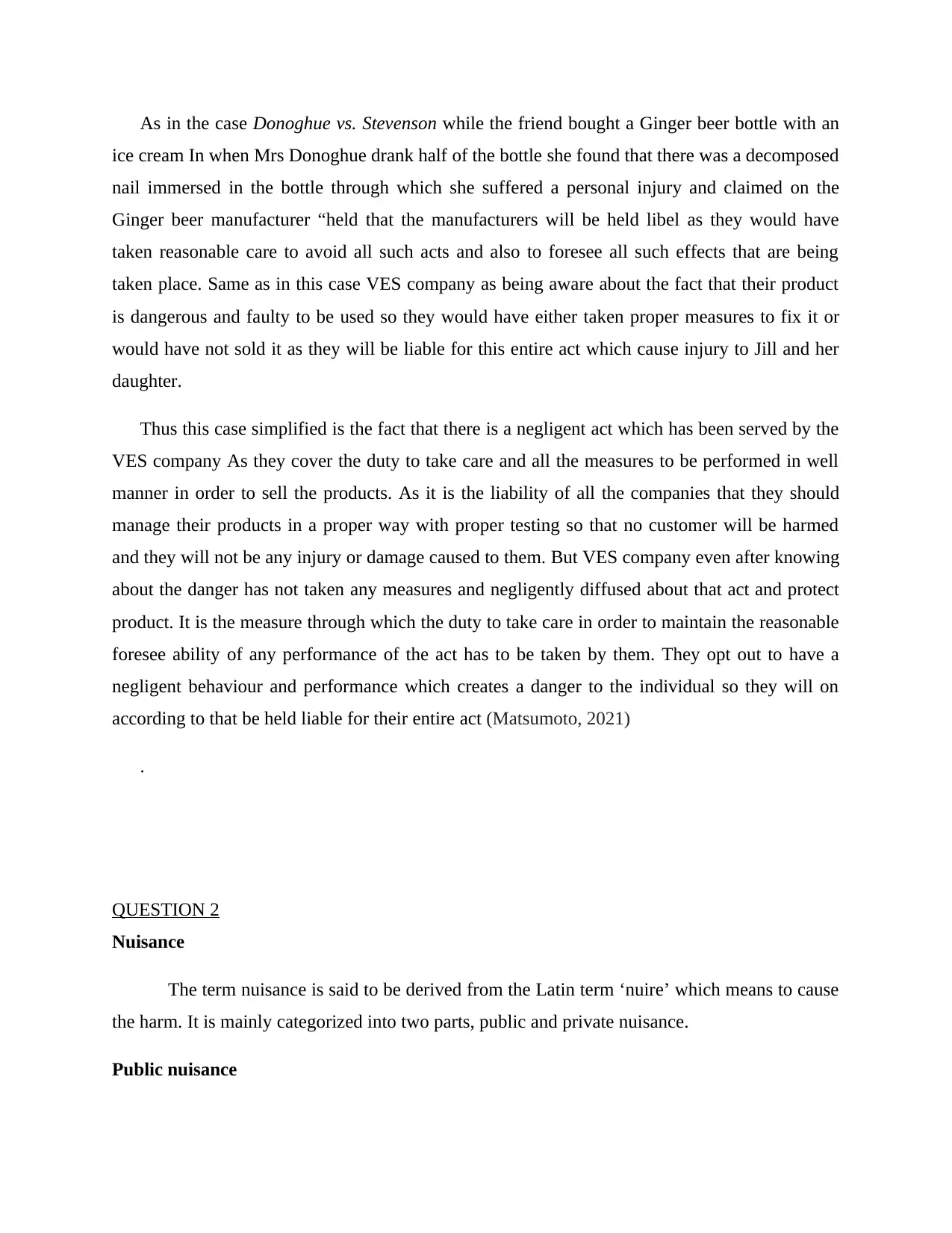
As in the case Donoghue vs. Stevenson while the friend bought a Ginger beer bottle with an
ice cream In when Mrs Donoghue drank half of the bottle she found that there was a decomposed
nail immersed in the bottle through which she suffered a personal injury and claimed on the
Ginger beer manufacturer “held that the manufacturers will be held libel as they would have
taken reasonable care to avoid all such acts and also to foresee all such effects that are being
taken place. Same as in this case VES company as being aware about the fact that their product
is dangerous and faulty to be used so they would have either taken proper measures to fix it or
would have not sold it as they will be liable for this entire act which cause injury to Jill and her
daughter.
Thus this case simplified is the fact that there is a negligent act which has been served by the
VES company As they cover the duty to take care and all the measures to be performed in well
manner in order to sell the products. As it is the liability of all the companies that they should
manage their products in a proper way with proper testing so that no customer will be harmed
and they will not be any injury or damage caused to them. But VES company even after knowing
about the danger has not taken any measures and negligently diffused about that act and protect
product. It is the measure through which the duty to take care in order to maintain the reasonable
foresee ability of any performance of the act has to be taken by them. They opt out to have a
negligent behaviour and performance which creates a danger to the individual so they will on
according to that be held liable for their entire act (Matsumoto, 2021)
.
QUESTION 2
Nuisance
The term nuisance is said to be derived from the Latin term ‘nuire’ which means to cause
the harm. It is mainly categorized into two parts, public and private nuisance.
Public nuisance
ice cream In when Mrs Donoghue drank half of the bottle she found that there was a decomposed
nail immersed in the bottle through which she suffered a personal injury and claimed on the
Ginger beer manufacturer “held that the manufacturers will be held libel as they would have
taken reasonable care to avoid all such acts and also to foresee all such effects that are being
taken place. Same as in this case VES company as being aware about the fact that their product
is dangerous and faulty to be used so they would have either taken proper measures to fix it or
would have not sold it as they will be liable for this entire act which cause injury to Jill and her
daughter.
Thus this case simplified is the fact that there is a negligent act which has been served by the
VES company As they cover the duty to take care and all the measures to be performed in well
manner in order to sell the products. As it is the liability of all the companies that they should
manage their products in a proper way with proper testing so that no customer will be harmed
and they will not be any injury or damage caused to them. But VES company even after knowing
about the danger has not taken any measures and negligently diffused about that act and protect
product. It is the measure through which the duty to take care in order to maintain the reasonable
foresee ability of any performance of the act has to be taken by them. They opt out to have a
negligent behaviour and performance which creates a danger to the individual so they will on
according to that be held liable for their entire act (Matsumoto, 2021)
.
QUESTION 2
Nuisance
The term nuisance is said to be derived from the Latin term ‘nuire’ which means to cause
the harm. It is mainly categorized into two parts, public and private nuisance.
Public nuisance
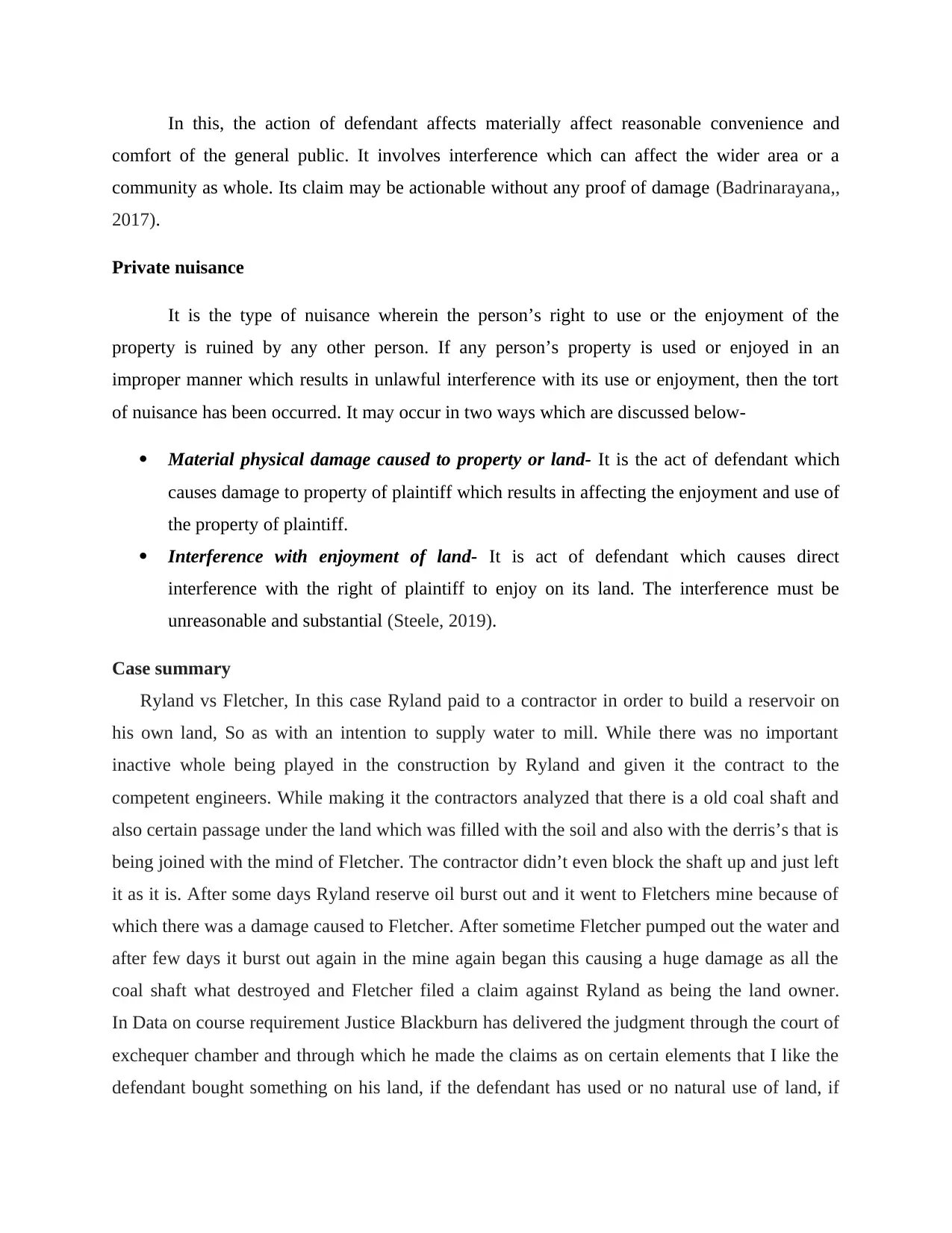
In this, the action of defendant affects materially affect reasonable convenience and
comfort of the general public. It involves interference which can affect the wider area or a
community as whole. Its claim may be actionable without any proof of damage (Badrinarayana,,
2017).
Private nuisance
It is the type of nuisance wherein the person’s right to use or the enjoyment of the
property is ruined by any other person. If any person’s property is used or enjoyed in an
improper manner which results in unlawful interference with its use or enjoyment, then the tort
of nuisance has been occurred. It may occur in two ways which are discussed below-
Material physical damage caused to property or land- It is the act of defendant which
causes damage to property of plaintiff which results in affecting the enjoyment and use of
the property of plaintiff.
Interference with enjoyment of land- It is act of defendant which causes direct
interference with the right of plaintiff to enjoy on its land. The interference must be
unreasonable and substantial (Steele, 2019).
Case summary
Ryland vs Fletcher, In this case Ryland paid to a contractor in order to build a reservoir on
his own land, So as with an intention to supply water to mill. While there was no important
inactive whole being played in the construction by Ryland and given it the contract to the
competent engineers. While making it the contractors analyzed that there is a old coal shaft and
also certain passage under the land which was filled with the soil and also with the derris’s that is
being joined with the mind of Fletcher. The contractor didn’t even block the shaft up and just left
it as it is. After some days Ryland reserve oil burst out and it went to Fletchers mine because of
which there was a damage caused to Fletcher. After sometime Fletcher pumped out the water and
after few days it burst out again in the mine again began this causing a huge damage as all the
coal shaft what destroyed and Fletcher filed a claim against Ryland as being the land owner.
In Data on course requirement Justice Blackburn has delivered the judgment through the court of
exchequer chamber and through which he made the claims as on certain elements that I like the
defendant bought something on his land, if the defendant has used or no natural use of land, if
comfort of the general public. It involves interference which can affect the wider area or a
community as whole. Its claim may be actionable without any proof of damage (Badrinarayana,,
2017).
Private nuisance
It is the type of nuisance wherein the person’s right to use or the enjoyment of the
property is ruined by any other person. If any person’s property is used or enjoyed in an
improper manner which results in unlawful interference with its use or enjoyment, then the tort
of nuisance has been occurred. It may occur in two ways which are discussed below-
Material physical damage caused to property or land- It is the act of defendant which
causes damage to property of plaintiff which results in affecting the enjoyment and use of
the property of plaintiff.
Interference with enjoyment of land- It is act of defendant which causes direct
interference with the right of plaintiff to enjoy on its land. The interference must be
unreasonable and substantial (Steele, 2019).
Case summary
Ryland vs Fletcher, In this case Ryland paid to a contractor in order to build a reservoir on
his own land, So as with an intention to supply water to mill. While there was no important
inactive whole being played in the construction by Ryland and given it the contract to the
competent engineers. While making it the contractors analyzed that there is a old coal shaft and
also certain passage under the land which was filled with the soil and also with the derris’s that is
being joined with the mind of Fletcher. The contractor didn’t even block the shaft up and just left
it as it is. After some days Ryland reserve oil burst out and it went to Fletchers mine because of
which there was a damage caused to Fletcher. After sometime Fletcher pumped out the water and
after few days it burst out again in the mine again began this causing a huge damage as all the
coal shaft what destroyed and Fletcher filed a claim against Ryland as being the land owner.
In Data on course requirement Justice Blackburn has delivered the judgment through the court of
exchequer chamber and through which he made the claims as on certain elements that I like the
defendant bought something on his land, if the defendant has used or no natural use of land, if
⊘ This is a preview!⊘
Do you want full access?
Subscribe today to unlock all pages.

Trusted by 1+ million students worldwide
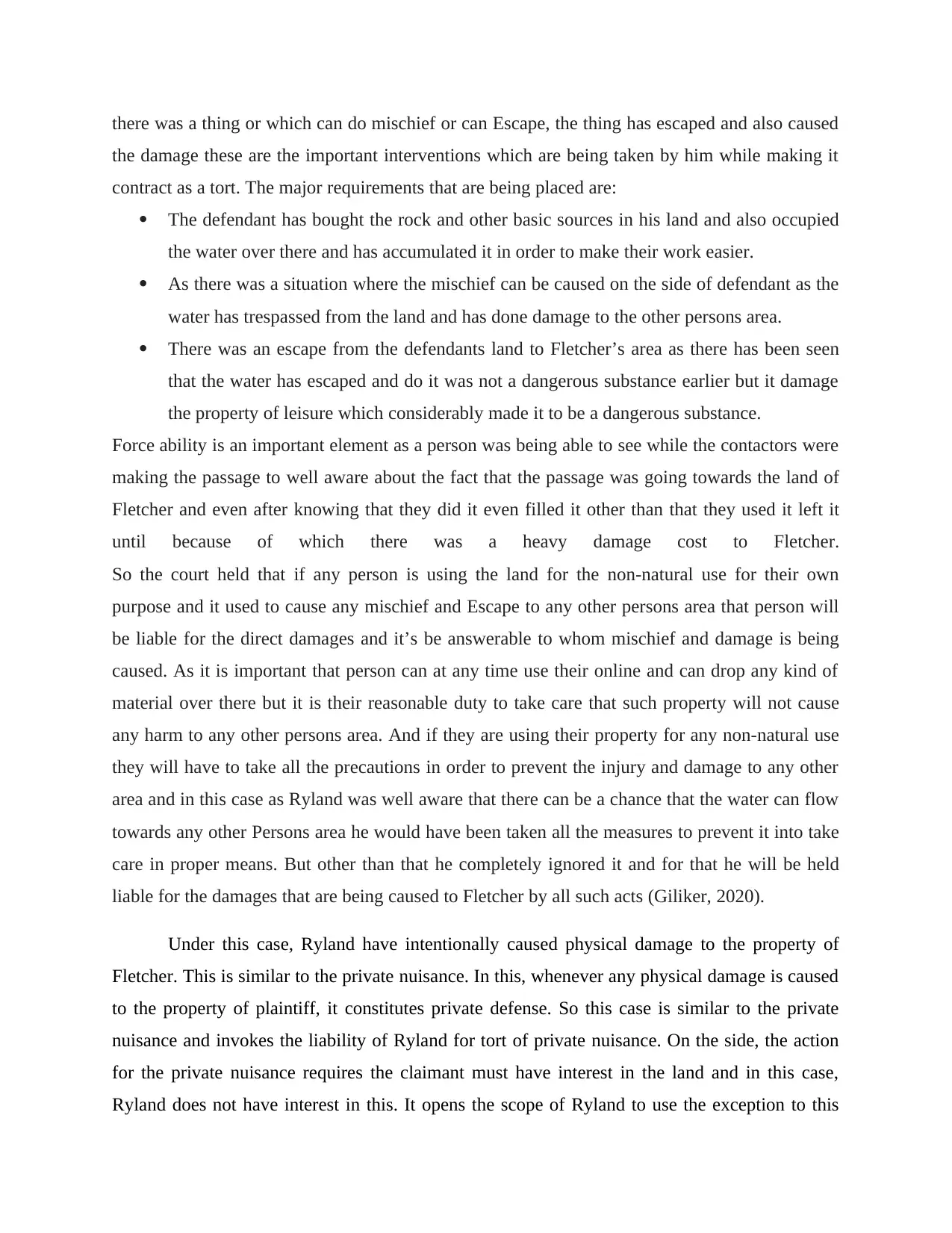
there was a thing or which can do mischief or can Escape, the thing has escaped and also caused
the damage these are the important interventions which are being taken by him while making it
contract as a tort. The major requirements that are being placed are:
The defendant has bought the rock and other basic sources in his land and also occupied
the water over there and has accumulated it in order to make their work easier.
As there was a situation where the mischief can be caused on the side of defendant as the
water has trespassed from the land and has done damage to the other persons area.
There was an escape from the defendants land to Fletcher’s area as there has been seen
that the water has escaped and do it was not a dangerous substance earlier but it damage
the property of leisure which considerably made it to be a dangerous substance.
Force ability is an important element as a person was being able to see while the contactors were
making the passage to well aware about the fact that the passage was going towards the land of
Fletcher and even after knowing that they did it even filled it other than that they used it left it
until because of which there was a heavy damage cost to Fletcher.
So the court held that if any person is using the land for the non-natural use for their own
purpose and it used to cause any mischief and Escape to any other persons area that person will
be liable for the direct damages and it’s be answerable to whom mischief and damage is being
caused. As it is important that person can at any time use their online and can drop any kind of
material over there but it is their reasonable duty to take care that such property will not cause
any harm to any other persons area. And if they are using their property for any non-natural use
they will have to take all the precautions in order to prevent the injury and damage to any other
area and in this case as Ryland was well aware that there can be a chance that the water can flow
towards any other Persons area he would have been taken all the measures to prevent it into take
care in proper means. But other than that he completely ignored it and for that he will be held
liable for the damages that are being caused to Fletcher by all such acts (Giliker, 2020).
Under this case, Ryland have intentionally caused physical damage to the property of
Fletcher. This is similar to the private nuisance. In this, whenever any physical damage is caused
to the property of plaintiff, it constitutes private defense. So this case is similar to the private
nuisance and invokes the liability of Ryland for tort of private nuisance. On the side, the action
for the private nuisance requires the claimant must have interest in the land and in this case,
Ryland does not have interest in this. It opens the scope of Ryland to use the exception to this
the damage these are the important interventions which are being taken by him while making it
contract as a tort. The major requirements that are being placed are:
The defendant has bought the rock and other basic sources in his land and also occupied
the water over there and has accumulated it in order to make their work easier.
As there was a situation where the mischief can be caused on the side of defendant as the
water has trespassed from the land and has done damage to the other persons area.
There was an escape from the defendants land to Fletcher’s area as there has been seen
that the water has escaped and do it was not a dangerous substance earlier but it damage
the property of leisure which considerably made it to be a dangerous substance.
Force ability is an important element as a person was being able to see while the contactors were
making the passage to well aware about the fact that the passage was going towards the land of
Fletcher and even after knowing that they did it even filled it other than that they used it left it
until because of which there was a heavy damage cost to Fletcher.
So the court held that if any person is using the land for the non-natural use for their own
purpose and it used to cause any mischief and Escape to any other persons area that person will
be liable for the direct damages and it’s be answerable to whom mischief and damage is being
caused. As it is important that person can at any time use their online and can drop any kind of
material over there but it is their reasonable duty to take care that such property will not cause
any harm to any other persons area. And if they are using their property for any non-natural use
they will have to take all the precautions in order to prevent the injury and damage to any other
area and in this case as Ryland was well aware that there can be a chance that the water can flow
towards any other Persons area he would have been taken all the measures to prevent it into take
care in proper means. But other than that he completely ignored it and for that he will be held
liable for the damages that are being caused to Fletcher by all such acts (Giliker, 2020).
Under this case, Ryland have intentionally caused physical damage to the property of
Fletcher. This is similar to the private nuisance. In this, whenever any physical damage is caused
to the property of plaintiff, it constitutes private defense. So this case is similar to the private
nuisance and invokes the liability of Ryland for tort of private nuisance. On the side, the action
for the private nuisance requires the claimant must have interest in the land and in this case,
Ryland does not have interest in this. It opens the scope of Ryland to use the exception to this
Paraphrase This Document
Need a fresh take? Get an instant paraphrase of this document with our AI Paraphraser
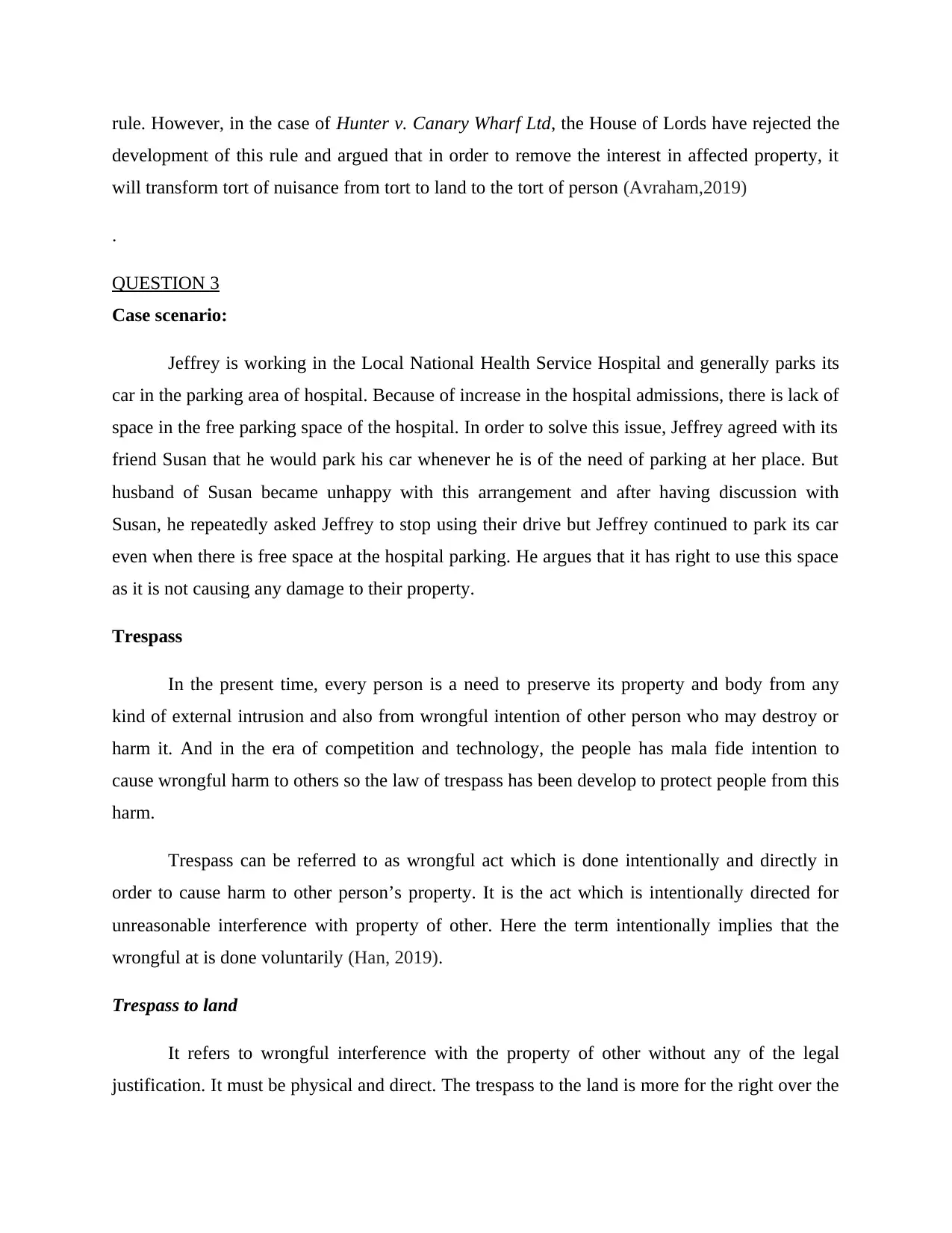
rule. However, in the case of Hunter v. Canary Wharf Ltd, the House of Lords have rejected the
development of this rule and argued that in order to remove the interest in affected property, it
will transform tort of nuisance from tort to land to the tort of person (Avraham,2019)
.
QUESTION 3
Case scenario:
Jeffrey is working in the Local National Health Service Hospital and generally parks its
car in the parking area of hospital. Because of increase in the hospital admissions, there is lack of
space in the free parking space of the hospital. In order to solve this issue, Jeffrey agreed with its
friend Susan that he would park his car whenever he is of the need of parking at her place. But
husband of Susan became unhappy with this arrangement and after having discussion with
Susan, he repeatedly asked Jeffrey to stop using their drive but Jeffrey continued to park its car
even when there is free space at the hospital parking. He argues that it has right to use this space
as it is not causing any damage to their property.
Trespass
In the present time, every person is a need to preserve its property and body from any
kind of external intrusion and also from wrongful intention of other person who may destroy or
harm it. And in the era of competition and technology, the people has mala fide intention to
cause wrongful harm to others so the law of trespass has been develop to protect people from this
harm.
Trespass can be referred to as wrongful act which is done intentionally and directly in
order to cause harm to other person’s property. It is the act which is intentionally directed for
unreasonable interference with property of other. Here the term intentionally implies that the
wrongful at is done voluntarily (Han, 2019).
Trespass to land
It refers to wrongful interference with the property of other without any of the legal
justification. It must be physical and direct. The trespass to the land is more for the right over the
development of this rule and argued that in order to remove the interest in affected property, it
will transform tort of nuisance from tort to land to the tort of person (Avraham,2019)
.
QUESTION 3
Case scenario:
Jeffrey is working in the Local National Health Service Hospital and generally parks its
car in the parking area of hospital. Because of increase in the hospital admissions, there is lack of
space in the free parking space of the hospital. In order to solve this issue, Jeffrey agreed with its
friend Susan that he would park his car whenever he is of the need of parking at her place. But
husband of Susan became unhappy with this arrangement and after having discussion with
Susan, he repeatedly asked Jeffrey to stop using their drive but Jeffrey continued to park its car
even when there is free space at the hospital parking. He argues that it has right to use this space
as it is not causing any damage to their property.
Trespass
In the present time, every person is a need to preserve its property and body from any
kind of external intrusion and also from wrongful intention of other person who may destroy or
harm it. And in the era of competition and technology, the people has mala fide intention to
cause wrongful harm to others so the law of trespass has been develop to protect people from this
harm.
Trespass can be referred to as wrongful act which is done intentionally and directly in
order to cause harm to other person’s property. It is the act which is intentionally directed for
unreasonable interference with property of other. Here the term intentionally implies that the
wrongful at is done voluntarily (Han, 2019).
Trespass to land
It refers to wrongful interference with the property of other without any of the legal
justification. It must be physical and direct. The trespass to the land is more for the right over the
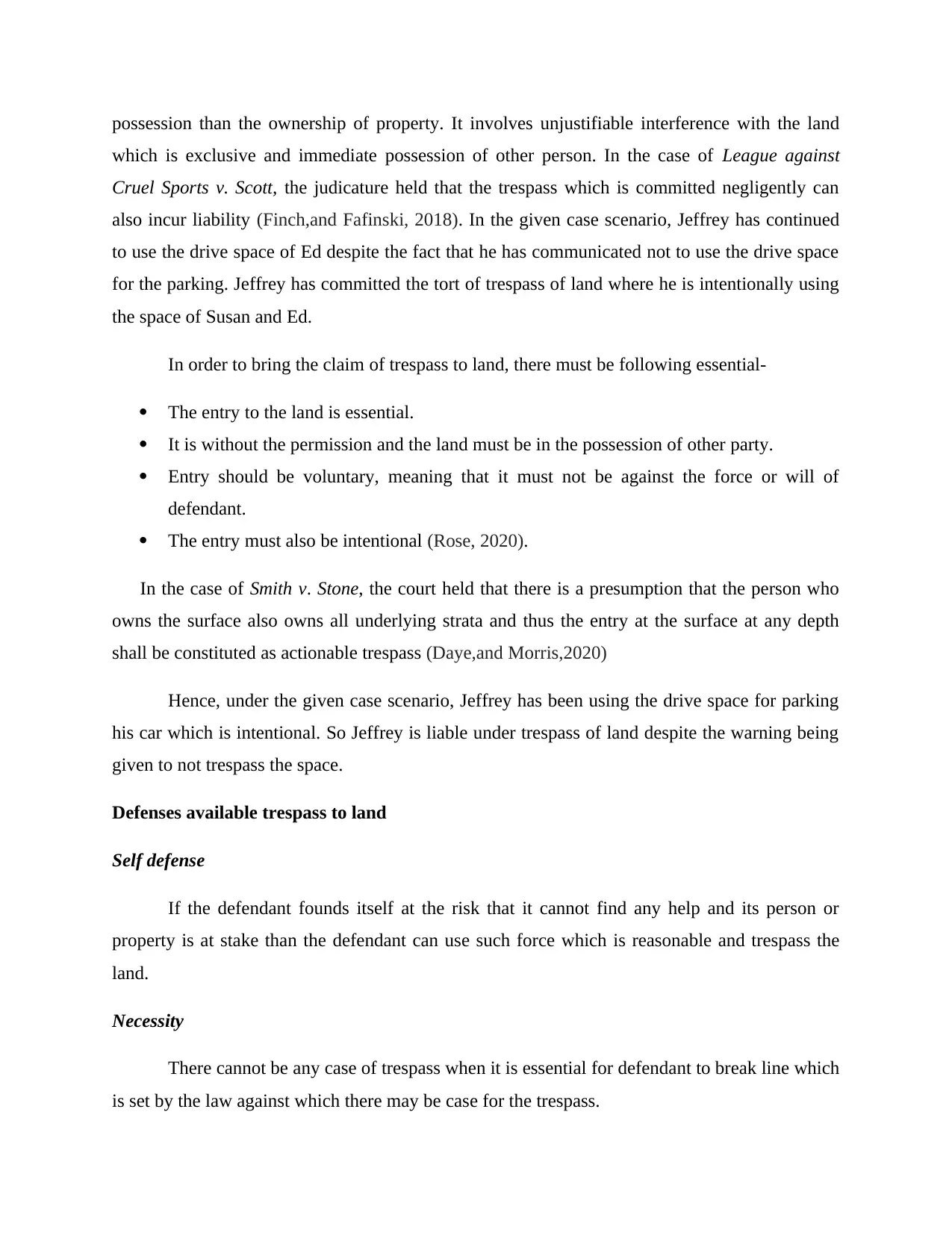
possession than the ownership of property. It involves unjustifiable interference with the land
which is exclusive and immediate possession of other person. In the case of League against
Cruel Sports v. Scott, the judicature held that the trespass which is committed negligently can
also incur liability (Finch,and Fafinski, 2018). In the given case scenario, Jeffrey has continued
to use the drive space of Ed despite the fact that he has communicated not to use the drive space
for the parking. Jeffrey has committed the tort of trespass of land where he is intentionally using
the space of Susan and Ed.
In order to bring the claim of trespass to land, there must be following essential-
The entry to the land is essential.
It is without the permission and the land must be in the possession of other party.
Entry should be voluntary, meaning that it must not be against the force or will of
defendant.
The entry must also be intentional (Rose, 2020).
In the case of Smith v. Stone, the court held that there is a presumption that the person who
owns the surface also owns all underlying strata and thus the entry at the surface at any depth
shall be constituted as actionable trespass (Daye,and Morris,2020)
Hence, under the given case scenario, Jeffrey has been using the drive space for parking
his car which is intentional. So Jeffrey is liable under trespass of land despite the warning being
given to not trespass the space.
Defenses available trespass to land
Self defense
If the defendant founds itself at the risk that it cannot find any help and its person or
property is at stake than the defendant can use such force which is reasonable and trespass the
land.
Necessity
There cannot be any case of trespass when it is essential for defendant to break line which
is set by the law against which there may be case for the trespass.
which is exclusive and immediate possession of other person. In the case of League against
Cruel Sports v. Scott, the judicature held that the trespass which is committed negligently can
also incur liability (Finch,and Fafinski, 2018). In the given case scenario, Jeffrey has continued
to use the drive space of Ed despite the fact that he has communicated not to use the drive space
for the parking. Jeffrey has committed the tort of trespass of land where he is intentionally using
the space of Susan and Ed.
In order to bring the claim of trespass to land, there must be following essential-
The entry to the land is essential.
It is without the permission and the land must be in the possession of other party.
Entry should be voluntary, meaning that it must not be against the force or will of
defendant.
The entry must also be intentional (Rose, 2020).
In the case of Smith v. Stone, the court held that there is a presumption that the person who
owns the surface also owns all underlying strata and thus the entry at the surface at any depth
shall be constituted as actionable trespass (Daye,and Morris,2020)
Hence, under the given case scenario, Jeffrey has been using the drive space for parking
his car which is intentional. So Jeffrey is liable under trespass of land despite the warning being
given to not trespass the space.
Defenses available trespass to land
Self defense
If the defendant founds itself at the risk that it cannot find any help and its person or
property is at stake than the defendant can use such force which is reasonable and trespass the
land.
Necessity
There cannot be any case of trespass when it is essential for defendant to break line which
is set by the law against which there may be case for the trespass.
⊘ This is a preview!⊘
Do you want full access?
Subscribe today to unlock all pages.

Trusted by 1+ million students worldwide
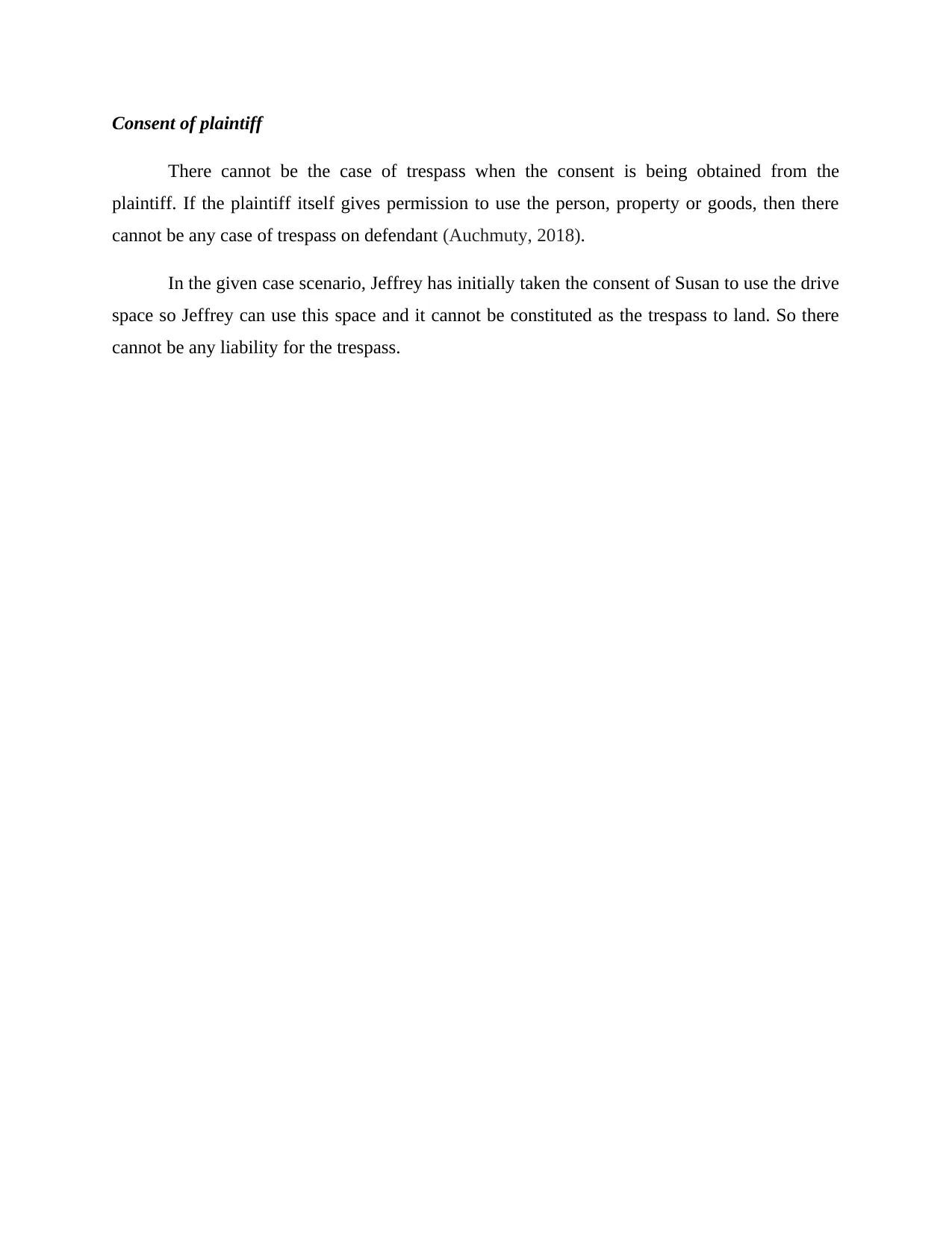
Consent of plaintiff
There cannot be the case of trespass when the consent is being obtained from the
plaintiff. If the plaintiff itself gives permission to use the person, property or goods, then there
cannot be any case of trespass on defendant (Auchmuty, 2018).
In the given case scenario, Jeffrey has initially taken the consent of Susan to use the drive
space so Jeffrey can use this space and it cannot be constituted as the trespass to land. So there
cannot be any liability for the trespass.
There cannot be the case of trespass when the consent is being obtained from the
plaintiff. If the plaintiff itself gives permission to use the person, property or goods, then there
cannot be any case of trespass on defendant (Auchmuty, 2018).
In the given case scenario, Jeffrey has initially taken the consent of Susan to use the drive
space so Jeffrey can use this space and it cannot be constituted as the trespass to land. So there
cannot be any liability for the trespass.
Paraphrase This Document
Need a fresh take? Get an instant paraphrase of this document with our AI Paraphraser
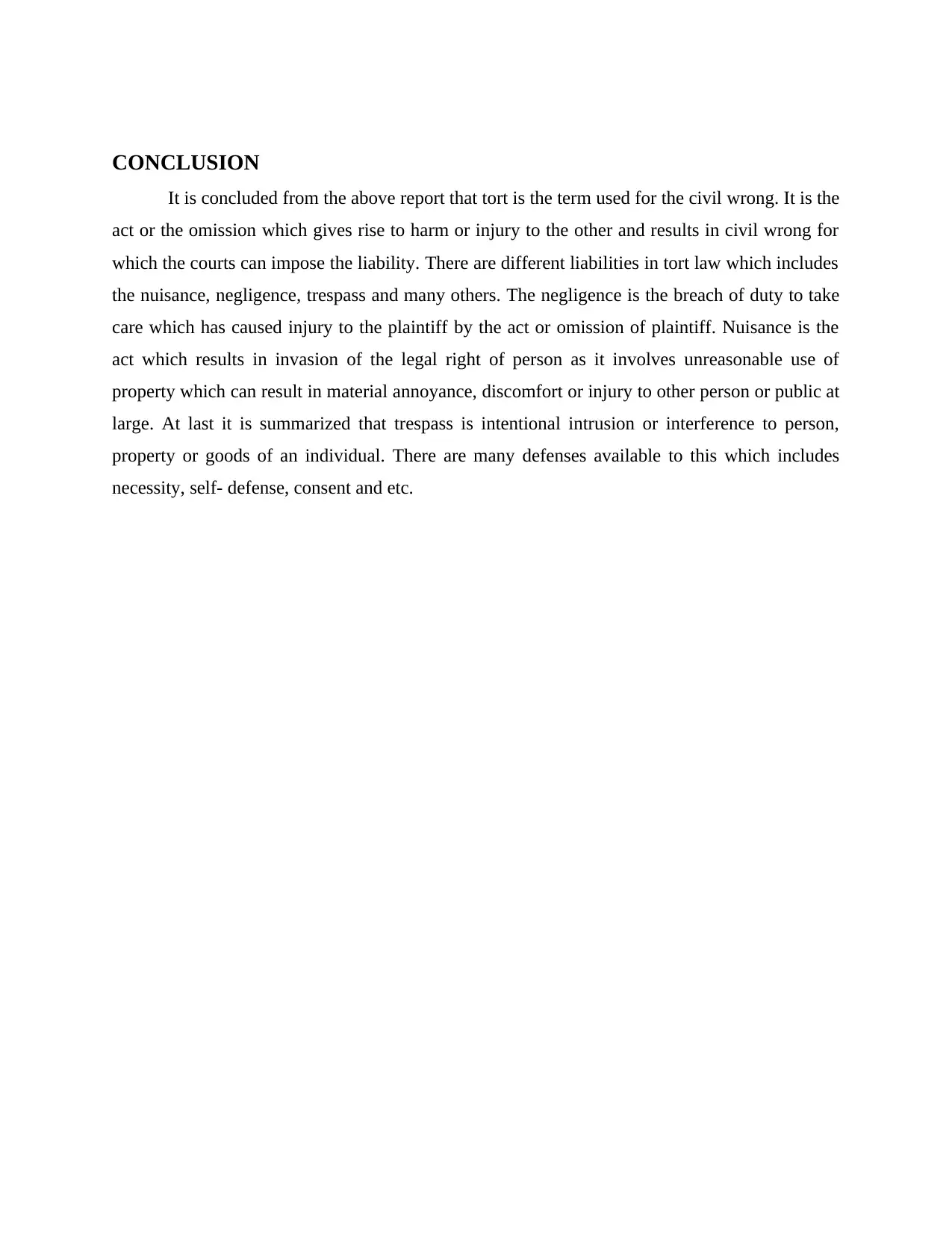
CONCLUSION
It is concluded from the above report that tort is the term used for the civil wrong. It is the
act or the omission which gives rise to harm or injury to the other and results in civil wrong for
which the courts can impose the liability. There are different liabilities in tort law which includes
the nuisance, negligence, trespass and many others. The negligence is the breach of duty to take
care which has caused injury to the plaintiff by the act or omission of plaintiff. Nuisance is the
act which results in invasion of the legal right of person as it involves unreasonable use of
property which can result in material annoyance, discomfort or injury to other person or public at
large. At last it is summarized that trespass is intentional intrusion or interference to person,
property or goods of an individual. There are many defenses available to this which includes
necessity, self- defense, consent and etc.
It is concluded from the above report that tort is the term used for the civil wrong. It is the
act or the omission which gives rise to harm or injury to the other and results in civil wrong for
which the courts can impose the liability. There are different liabilities in tort law which includes
the nuisance, negligence, trespass and many others. The negligence is the breach of duty to take
care which has caused injury to the plaintiff by the act or omission of plaintiff. Nuisance is the
act which results in invasion of the legal right of person as it involves unreasonable use of
property which can result in material annoyance, discomfort or injury to other person or public at
large. At last it is summarized that trespass is intentional intrusion or interference to person,
property or goods of an individual. There are many defenses available to this which includes
necessity, self- defense, consent and etc.
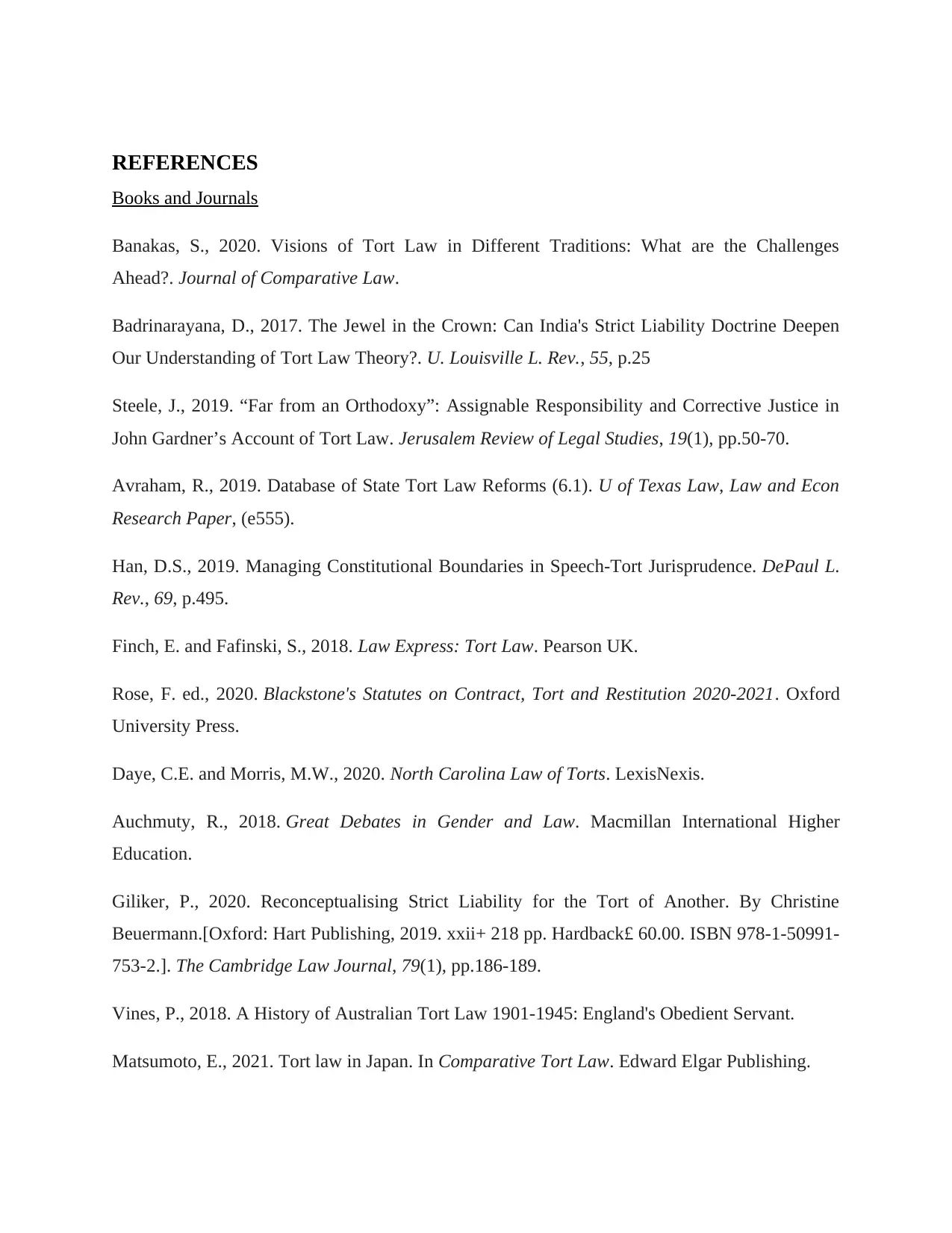
REFERENCES
Books and Journals
Banakas, S., 2020. Visions of Tort Law in Different Traditions: What are the Challenges
Ahead?. Journal of Comparative Law.
Badrinarayana, D., 2017. The Jewel in the Crown: Can India's Strict Liability Doctrine Deepen
Our Understanding of Tort Law Theory?. U. Louisville L. Rev., 55, p.25
Steele, J., 2019. “Far from an Orthodoxy”: Assignable Responsibility and Corrective Justice in
John Gardner’s Account of Tort Law. Jerusalem Review of Legal Studies, 19(1), pp.50-70.
Avraham, R., 2019. Database of State Tort Law Reforms (6.1). U of Texas Law, Law and Econ
Research Paper, (e555).
Han, D.S., 2019. Managing Constitutional Boundaries in Speech-Tort Jurisprudence. DePaul L.
Rev., 69, p.495.
Finch, E. and Fafinski, S., 2018. Law Express: Tort Law. Pearson UK.
Rose, F. ed., 2020. Blackstone's Statutes on Contract, Tort and Restitution 2020-2021. Oxford
University Press.
Daye, C.E. and Morris, M.W., 2020. North Carolina Law of Torts. LexisNexis.
Auchmuty, R., 2018. Great Debates in Gender and Law. Macmillan International Higher
Education.
Giliker, P., 2020. Reconceptualising Strict Liability for the Tort of Another. By Christine
Beuermann.[Oxford: Hart Publishing, 2019. xxii+ 218 pp. Hardback£ 60.00. ISBN 978-1-50991-
753-2.]. The Cambridge Law Journal, 79(1), pp.186-189.
Vines, P., 2018. A History of Australian Tort Law 1901-1945: England's Obedient Servant.
Matsumoto, E., 2021. Tort law in Japan. In Comparative Tort Law. Edward Elgar Publishing.
Books and Journals
Banakas, S., 2020. Visions of Tort Law in Different Traditions: What are the Challenges
Ahead?. Journal of Comparative Law.
Badrinarayana, D., 2017. The Jewel in the Crown: Can India's Strict Liability Doctrine Deepen
Our Understanding of Tort Law Theory?. U. Louisville L. Rev., 55, p.25
Steele, J., 2019. “Far from an Orthodoxy”: Assignable Responsibility and Corrective Justice in
John Gardner’s Account of Tort Law. Jerusalem Review of Legal Studies, 19(1), pp.50-70.
Avraham, R., 2019. Database of State Tort Law Reforms (6.1). U of Texas Law, Law and Econ
Research Paper, (e555).
Han, D.S., 2019. Managing Constitutional Boundaries in Speech-Tort Jurisprudence. DePaul L.
Rev., 69, p.495.
Finch, E. and Fafinski, S., 2018. Law Express: Tort Law. Pearson UK.
Rose, F. ed., 2020. Blackstone's Statutes on Contract, Tort and Restitution 2020-2021. Oxford
University Press.
Daye, C.E. and Morris, M.W., 2020. North Carolina Law of Torts. LexisNexis.
Auchmuty, R., 2018. Great Debates in Gender and Law. Macmillan International Higher
Education.
Giliker, P., 2020. Reconceptualising Strict Liability for the Tort of Another. By Christine
Beuermann.[Oxford: Hart Publishing, 2019. xxii+ 218 pp. Hardback£ 60.00. ISBN 978-1-50991-
753-2.]. The Cambridge Law Journal, 79(1), pp.186-189.
Vines, P., 2018. A History of Australian Tort Law 1901-1945: England's Obedient Servant.
Matsumoto, E., 2021. Tort law in Japan. In Comparative Tort Law. Edward Elgar Publishing.
⊘ This is a preview!⊘
Do you want full access?
Subscribe today to unlock all pages.

Trusted by 1+ million students worldwide
1 out of 13
Related Documents
Your All-in-One AI-Powered Toolkit for Academic Success.
+13062052269
info@desklib.com
Available 24*7 on WhatsApp / Email
![[object Object]](/_next/static/media/star-bottom.7253800d.svg)
Unlock your academic potential
Copyright © 2020–2025 A2Z Services. All Rights Reserved. Developed and managed by ZUCOL.





